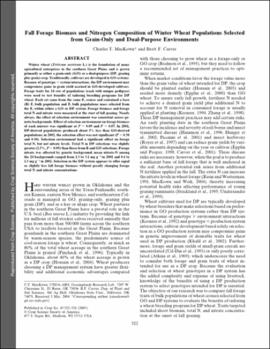| dc.contributor.author | MacKown, Charles T. | |
| dc.contributor.author | Carver, Brett F. | |
| dc.date.accessioned | 2015-10-16T20:47:50Z | |
| dc.date.available | 2015-10-16T20:47:50Z | |
| dc.date.issued | 2005-01 | |
| dc.identifier | okds_Carver_CS_1993-01.pdf | |
| dc.identifier.citation | MacKown, C. T., & Carver, B. F. (2005). Fall forage biomass and nitrogen composition of winter wheat populations selected from grain-only and dual-purpose environments. Crop Science, 45(1), 322-328. https://doi.org/10.2135/cropsci2005.0322 | |
| dc.identifier.uri | https://hdl.handle.net/11244/19796 | |
| dc.description.abstract | Winter wheat (Triticum aestivum L.) is the foundation of many agricultural enterprises in the southern Great Plains and is grown primarily as either a grain-only (GO) or a dual-purpose (DP, grazing plus grain) crop. Traditionally, cultivars are developed in GO systems. Because of genotype X system interactions, the DP environment may compromise gains in grain yield accrued in GO-developed cultivars. Forage traits for 24 sets of populations (each with unique pedigree) were used to test benefits of tailoring breeding programs for DP wheat. Each set came from the same F2 source and contained a base (B) F3 bulk population and F5 bulk populations mass selected from the F2 within either a GO or DP system. Forage biomass and forage total N and nitrate were measured at the start of fall grazing. Nearly always, the effect of selection environment was consistent across genetic backgrounds. Effect of selection environment on forage biomass of each nursery was significant at P = 0.09 and P = 0.07. In 2001, DP-derived populations produced about 5% less than GO-derived populations; in 2002, the selection effect was not significant (P = 0.38 and 0.30). Selection environment had a significant effect on forage total N, but not nitrate levels. Total N in DP selections was slightly greater (2.5%, P < 0.05) than those from B and GO selections. Forage nitrate was affected by genetic background; mean nitrate-N among the 24 backgrounds ranged from 1.3 to 3.1 mg g^-1 in 2001 and 0.4 to 1.3 mg g^-1 in 2002. Selection in the DP system appears to offer equal or slightly less fall forage biomass without greatly changing forage total N and nitrate concentrations. | |
| dc.format | application/pdf | |
| dc.language | en_US | |
| dc.publisher | Crop Science Society of America | |
| dc.rights | This material has been previously published. In the Oklahoma State University Library's institutional repository this version is made available through the open access principles and the terms of agreement/consent between the author(s) and the publisher. The permission policy on the use, reproduction or distribution of the material falls under fair use for educational, scholarship, and research purposes. Contact Digital Resources and Discovery Services at lib-dls@okstate.edu or 405-744-9161 for further information. | |
| dc.title | Fall forage biomass and nitrogen composition of winter wheat populations selected from grain-only and dual-purpose environments | |
| osu.filename | okds_Carver_CS_1993-01.pdf | |
| dc.description.peerreview | Peer reviewed | |
| dc.identifier.doi | 10.2135/cropsci2005.0322 | |
| dc.description.department | Plant and Soil Sciences | |
| dc.type.genre | Article | |
| dc.type.material | Text | |
